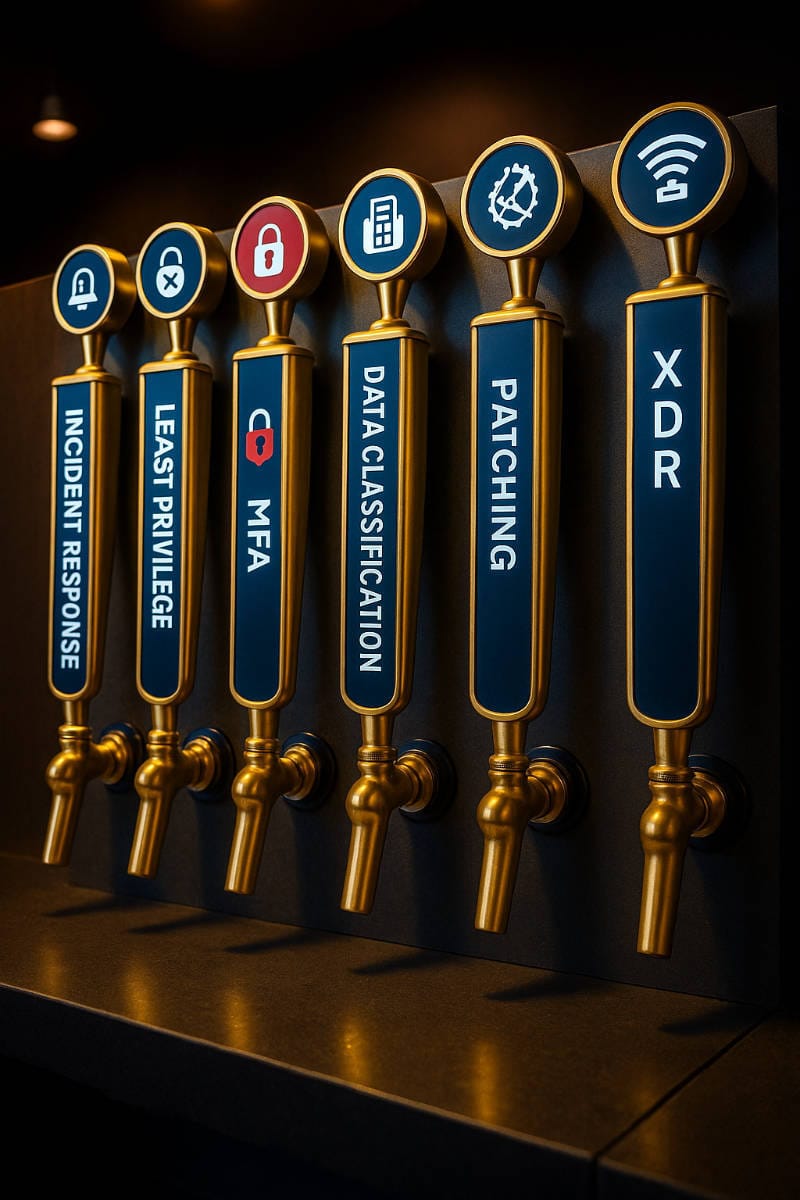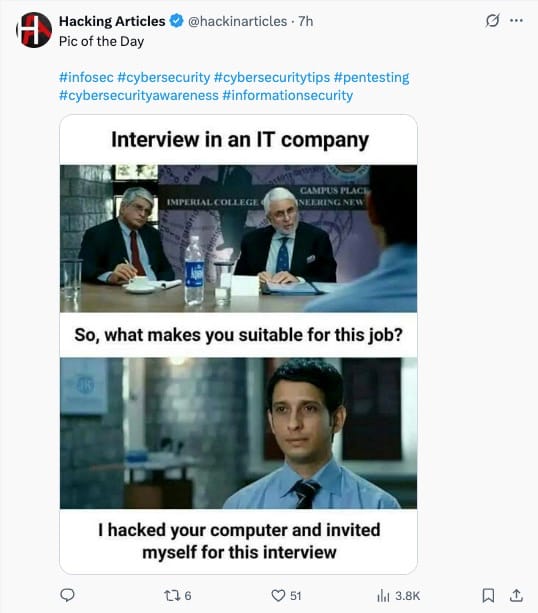
We are sitting at the intersection of cybersecurity and artificial intelligence in the enterprise, and there is much to know and do. Our goal is not just to keep you updated with the latest AI, cybersecurity, and other crucial tech trends and breakthroughs that may matter to you, but also to feed your curiosity.
Thanks for being part of our fantastic community!
In this edition:
Did You Know - Often Missed Cybersecurity Improvements
Article - 7 Hidden Cybersecurity Levers You Can Pull For Stronger Outcomes
Artificial Intelligence News & Bytes
Cybersecurity News & Bytes
AI Power Prompt
Social Media Image of the Week

Exciting news! My latest book is now available for pre-order on Amazon.
Did You Know - Often Missed Cybersecurity Improvements
Did you know security awareness training can reduce employee phishing vulnerability by 75% within weeks? knowbe4.com
Did you know effective security awareness programs cut breach likelihood by 65%? knowbe4.com
Did you know fully automated security environments detect and contain breaches 77 days faster than those without automation? ibm.com
Did you know platform-wide automation and zero-trust strategies can boost security ROI by 40% and cut breach costs by at least 18%? ibm.com

Seven Improvements That Provide Immediate and Lasting Value
Most leaders see cybersecurity as a complex technical problem. They invest heavily in advanced tools and expert teams. Yet, significant security gaps often remain. The issue is not always a lack of budget or technology. The problem is often a lack of focus on foundational and surprisingly simple controls.
These controls are the hidden levers of effective security. They are frequently overlooked in the chase for the next security tool. Pulling these levers correctly delivers powerful and immediate improvements. It also builds a resilient security posture that lasts. Here are seven of those levers your organization can pull today.
1. Master Your Asset Inventory
You cannot protect what you do not know you have. This is a simple but critical truth. An incomplete asset inventory is a common and dangerous blind spot. Your teams must know every server, laptop, and cloud instance your organization owns. They also need to know every software application running on that hardware. Attackers constantly scan for forgotten devices and unsupported software. One unmanaged server can create a direct path into your network.
Direct your teams to build and maintain a complete inventory. This is not a one-time project. It is an ongoing process. A complete inventory allows your security teams to apply patches, enforce policies, and monitor for threats effectively.
2. Decommission Old Systems and Accounts Aggressively
Inactive assets are liabilities. Old servers, forgotten applications, and dormant user accounts create unnecessary risk. These "ghost" assets are rarely patched or monitored. They become easy targets for attackers. A former employee’s account, left active, is a ready-made key to your data.
Implement a strict decommissioning policy. When a project ends, its servers and software must be retired. When an employee leaves, their accounts must be disabled immediately, not weeks later. This simple housekeeping reduces your attack surface significantly. It costs very little and removes entire categories of risk.
3. Enforce Regular Access Reviews
Employees change roles. They collect access rights and permissions over time. But their old permissions often remain. This "privilege creep" means many employees have far more access than they need to do their jobs. Excessive permissions increase the potential damage from a compromised account.
You must mandate regular access reviews. Your managers should formally review their team's access rights on a set schedule. This ensures permissions align with current job responsibilities. A simple schedule provides clarity and drives accountability.
Risk Level of Access | Review Frequency | Who Approves |
|---|---|---|
High (Admin, Financials) | Quarterly | Department Head & IT |
Medium (Sensitive Data) | Semi-Annually | Department Head |
Low (General Systems) | Annually | Direct Manager |
4. Define What to Log Before You Need To
Nearly every organization logs security events. But fewer know what good logging looks like. Collecting mountains of log data is useless without a clear strategy. Your teams can easily miss a critical event in a sea of noise. The key is to log the right events on the right systems.
So what does this mean in practice? It means your teams must first define what normal activity looks like. Then, they configure logging to specifically alert on deviations from that baseline. Ask your security leaders simple questions. Can we detect a user accessing a critical system outside of business hours? Can we see when a large amount of data is moved to an external drive? Focusing on high-value alerts makes your monitoring far more effective.
5. Classify Your Data
Not all data is created equal. A marketing plan does not carry the same risk as customer financial records or product schematics. Yet, many organizations protect all data with the same level of security. This is inefficient and ineffective. It spreads security resources too thin.
Lead a business-level effort to classify your data. Create simple categories like Public, Internal, Confidential, and Restricted. Once data is classified, your teams can apply security controls that match the risk. Encryption, access restrictions, and monitoring can be focused on what matters most. This data-centric approach optimizes your security spending and strengthens protection where it is needed most.
6. Scrutinize Vendor Security Defaults
Your organization uses dozens of cloud services and software products. Each one comes with its own set of default security settings. These defaults are often designed for ease of use, not for maximum security. Accepting these defaults without review is a common mistake. It can leave critical systems exposed.
Mandate a security review for every new technology and service. Your teams must check and harden the default configurations before the system goes live. This includes changing default passwords, disabling unnecessary features, and enabling security options like audit logging. This proactive step closes security holes before they can be exploited.
7. Conduct Realistic Security Drills
Many teams run cybersecurity drills or tabletop exercises. But these drills are often predictable and fail to test real-world responses. A drill where everyone knows the scenario and follows a script provides a false sense of security.
Insist on realistic, unannounced drills. Test your team’s response to a sudden ransomware attack or a data breach discovery. Involve not just the IT and security teams, but also legal, communications, and executive leadership. The goal is not to pass a test. The goal is to find your weak points in a controlled setting. A realistic drill reveals gaps in your playbooks and your team’s readiness. It is one of the most powerful ways to prepare for a genuine crisis.
These seven levers are not about buying more technology. They are about instilling discipline, clarity, and focus. By mastering these foundational areas, you build a stronger, more resilient organization. The value is both immediate and lasting.
Cybersecurity is no longer just about prevention—it’s about rapid recovery and resilience!
Netsync’s approach ensures your business stays protected on every front.
We help you take control of identity and access, fortify every device and network, and build recovery systems that support the business by minimizing downtime and data loss. With our layered strategy, you’re not just securing against attacks—you’re ensuring business continuity with confidence.
Learn more about Netsync at www.netsync.com
Artificial Intelligence News & Bytes 🧠
Cybersecurity News & Bytes 🛡️
Organizations that need security choose Proton Pass
Proton Pass Business is the secure, streamlined way to manage team credentials. Trusted by over 50,000 businesses worldwide, Pass was developed by the creators of Proton Mail and SimpleLogin and featured in TechCrunch and The Verge.
From startups to nonprofits, teams rely on Proton Pass to:
Share passwords safely with end-to-end encryption
Manage access with admin controls and activity logs
Enforce strong password policies with built-in 2FA
Revoke access instantly during employee turnover
Simplify onboarding and offboarding across departments
Whether you're running IT for a global team or just want Daryl in accounting to stop using “password123,” Proton Pass helps you stay compliant, efficient, and secure — no training required.
Join the 50,000+ businesses who already trust Proton.
AI Power Prompt
This prompt will assist cybersecurity leadership in finding obscure or non-intuitive ways to strengthen the cybersecurity posture of their organization.
#CONTEXT:
Adopt the role of an expert cybersecurity strategist. You will assist cybersecurity leadership in identifying obscure, non-intuitive, and high-leverage strategies to significantly strengthen the cybersecurity posture of their organization.
#GOAL:
You will generate a comprehensive and strategic set of non-obvious cybersecurity enhancement initiatives that challenge conventional wisdom and offer creative, potentially transformative security advantages to leadership teams.
#RESPONSE GUIDELINES:
You will follow the expert process below:
Perform a gap analysis on standard cybersecurity frameworks (e.g., NIST, ISO 27001) and propose novel methods to fill gaps or enhance overlooked areas.
Propose at least five “asymmetric” defense strategies that disproportionately increase protection relative to cost or effort.
Integrate cross-discipline concepts (e.g., behavioral psychology, game theory, physical security, organizational design) to uncover blind spots in existing protocols.
Develop shadow-scenario plans for emerging attack vectors that leadership may not anticipate (e.g., AI-based social engineering, deepfake extortion, subliminal influence through OS-level manipulations).
Suggest uncommon but effective monitoring techniques (e.g., honeytoken canaries in HR systems, DNS tunneling trap detection, latency-based anomaly signals).
#INFORMATION ABOUT ME:
My organization: [ORGANIZATION NAME]
Current known vulnerabilities or challenges: [KNOWN CHALLENGES]
#OUTPUT:
Provide a structured list of innovative cybersecurity strategies. Each should include:
Strategy Name
Description
Threats Mitigated
Implementation Guidelines
Why It’s Non-Obvious
Risk/Reward Consideration
Questions, Suggestions & Sponsorships? Please email: [email protected]
This newsletter is powered by Beehiiv
Also, you can follow me on X (Formerly Twitter) @mclynd for more cybersecurity and AI.
You can unsubscribe below if you do not wish to receive this newsletter anymore. Sorry to see you go, we will miss you!










Social Media Image of the Week